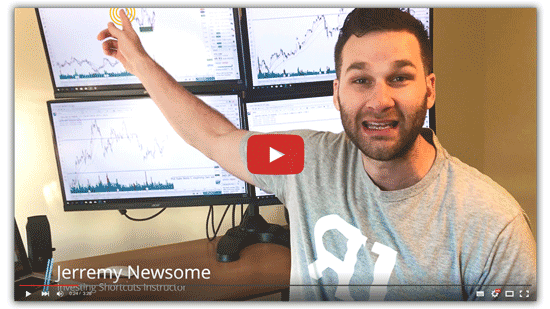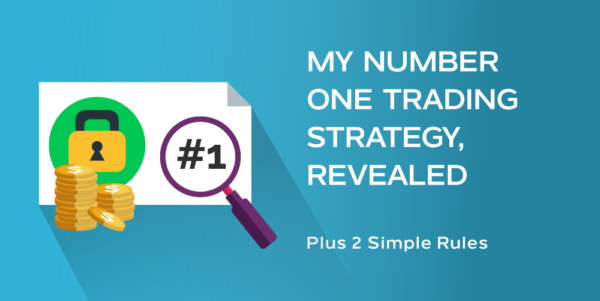Check out this video covering the three steps to the easiest trade setup in the world. Even the most novice trader can pick up a win using this approach outlined by RealLifeTrading.com founder, Jerremy Alexander Newsome.
Watch Now!
Investing Shortcuts – Easiest Trade Setup in the World from Investing Shortcuts on Vimeo.
Check Out the Transcript Below…
Hey stock market fans, traders, people, students from around the world. What’s going on? My name is Jerremy Alexander Newsome. Thank you so much for tuning into this Investing Shortcut. Hope you’re doing absolutely wonderful today. We got a great video, a very easy video. In fact, the title of the video is The Easiest Trade Setup in the World, and I appreciate you watching, and thanks so much.
So great video concept, I love the request, and this was actually brought to us by request from a lot of you from the comments section below. Again, you’re welcome to always post any questions, concerns, comments down there, but let’s talk about the easiest trade set-up in the world, and what’s interesting about that concept is just knowing that all investing takes time, right?
Warren Buffett said that the stock market is a great dictator between who is patient and wealthy, and impatient and broke. So with that being said, the easiest trade setup in the world comes down to a few things…
Number One: Find a Stock That You Interact with Every Day
Number one, what you want to approach, and what you wanna do is you want to find a stock that you interact with every day, every single day. So what I mean by interact with, I mean this is a stock, this is a company that you use often, so it can be a product that you use, a service that you use, something that you know of every single day. I’ll give you some examples: Verizon, Sprint, Google, Yahoo, British Petroleum, Netflix, Apple, Microsoft, Coca-Cola, Pepsi, Domino’s Pizza, right, Krispy Kreme Donuts, any stock, any company, sit down and think about it for a while.
What’s a company that I interact with all the time? Maybe you love buying clothes from Nike, right, or perhaps you love trading silver, or, potentially, you love going to see movies, and you want to … What is it, Lionsgate. Lionsgate, give me a second. Sorry, I gotta go over to the stock. Lionsgate Entertainment, right? Maybe you love going to see movies, and you like owning shares of Lionsgate, potentially, could be anything. So what you do from that is you find a stock or a company that you interact with every single day. Then you simply pull up the chart in some kind of charting software.
Now this charting software can be any charting software that you choose. You can do it in in ThinkorSwim, which is a broker. You can simply go to Yahoo Finance. I mean, you can do a very simplistic viewpoint. We’ll just go to Yahoo Finance, and you determine exactly where, you know, what stock is, and just type it in, right? So let’s say it is a stock that you interact with everyday, Facebook, right?
Every single day, I go look at Facebook, so you pull Facebook up, and you can click on this chart right here, interactive chart, you pull it up. So the thing is, you have to look at the chart first. The trade set-up is actually quite simple. What you’re gonna do is you’re gonna pull up the stock, the company that you interact with every single day, and you are going to put up a line chart, which is the easiest one to use. You got your line chart up, and you’re going to draw two lines. You’re gonna draw two support lines. You’re gonna draw a line at the all time high the stock’s ever been, and you’re gonna draw a support line. So those are the two lines that you’re gonna draw, and the easiest trade setup in the world is this…
When you finally find that one stock, so you might have to go through 10 of these, right? Maybe you have to go through 10 different stocks to find the winner, but you go through 10 stocks of companies that you know, that you like, that you use every single day, that if you mentioned them to a friend, they’d be like, “Oh yeah, I know that stock.” You go through a list of those stocks, you find one that you like, and then you find the one that is at a support level. You find a stock that is at a price that it has been to before, in which it has bounced.
So it just so happens that Lionsgate did a really good example. What you’ll notice here, we’ve bounced at this particular price before, and we are here again. So you simply find a stock that you interact with every single day, draw two lines, the all time high, and then a support level of where we are at, and I’ll do this on a few other examples.
So let’s do, and we might come back to Lionsgate, but let’s go do British Petroleum as one. So here’s British Petroleum, and you’re welcome go to the weekly chart if you want, or a daily chart. It depends, and this is going to be part number two of the trade set-up, but number two, you gotta ask the question how long do you want to be in the trade? All right, so that’s number one. Number one, finding the stock that you wanna buy, the company that you wanna trade.
Number Two: Determine How Long You Will Be in the Trade
Number two, how long do you wanna be in that trade? Answer that question. The longer you wanna be in a trade, the more money you should probably, or consider putting into that investment. So if it’s like a day, you’re probably not gonna be putting that much money into the trade, right? That’s not an investment, that’s a day trade, but think about this.
Let’s look at British Petroleum, and I have a lot of lines on British Petroleum, but let’s use this line in particular, here at 26.87. So you’ll notice right now, BP is up here around the 32 dollar range, so you might be saying, “All right, well Jerremy, Mister Smart Man, what do I do if I wanna buy at 26.87?” Well, the beautiful part is you’d have to wait, right? Remember the Warren Buffett quote. The stock market is a great dictator of who’s patient and wealthy. So if you wanted, to buy British Petroleum at 26.87, you’re gonna have to wait for it to come down there.
What if it never comes down there? Then I guess you never buy it at 26.87, do you? There’s a few strategies that you could get paid to be patient, to potentially buy down there, aka put sales, but let’s say that you look at British Petroleum, and you’re drawing your lines, you’re like, “You know what, it’s not at my support, I’m gonna move on.” Okay, cool.
What about Facebook? You pull up Facebook, and you’re like, “Man, Facebook is cruising. In fact, it’s all all time highs right now, so I’d like to buy it at 114 which is a support level, right, but it’s just going straight up, so I don’t wanna buy right there. I wanna buy something a little bit more cheap.”
Okay, what about Hanes Brand? Ticker symbol HBI. So you pull up Hanes Brands. You look at it, and you’re like, “Well, I’m looking at this. I don’t really see an obvious level of support, so I’m gonna keep looking.” And you keep going though these stocks, until you’re comfortable, until you know what the stock does, until you know what the company does, and that’s where you can buy it.
So let’s go look at American Outdoor Brand, ticker symbol AOBC. Now this stock just recently had a name change, but it was Smith & Wesson, so we’re all familiar with Smith & Wesson. So right now, if we pull up the line charts, you’ll notice I have this price here on American Outdoor Brands at 17 bucks. So what if, again, AOBC trades down to 16 bucks, right? That’s your support level. One big support on a stock that you like, and here’s the resistance.
So the trade setup is you simply wait for a stock to trade into a major support and resistance level, specifically the support price, right? It can be an old resistance like this one, or, preferably, you want it to be a new support. Now, the beautiful part is you never know if the trade is going to work or not, but again, that’s why you ask the question how long do I wanna be in this trade? The longer you wanna be in the trade, the more leeway you will give that trade.
Number Three: How Much Are You Willing to Lose on the Trade?
So let’s do some math really quick. Number three is you wanna figure out how much am I okay, or how much am I willing to lose on the trade? It’s a big question to ask. How much am I willing to lose on the trade? If your answer is $1,000, if you’re like, “This is the amount of money that I’m comfortable ‘losing on the trade’, right, not the amount of money that you’re going to invest, the amount of money that you’re going to lose if you’re wrong. So what you do is you do some math, and I’ll kind of show this to you really quick.
So, for example, if AOBC, American Outdoor Brands, trades down to 17, then you just simply look at the chart, and you go, “You know what? If it came all the way down to 14, at that point, I’d probably be wrong. I would just be wrong. I wouldn’t be right.” So you take the difference between where you wanna get in, 17, and where you wanna get out, 14. That’s three dollars, and then you divide this number by three. So again, whatever number you’re comfortable losing, so $1000 divided by three, and you’re gonna come up with an amount of shares, 333.
So as a recap, the longer you wanna buy the trade, the bigger this number should be, and the bigger your stock should be from where you get out. All right, because if you’re gonna be in this trade a long time, you don’t necessarily matter and you don’t care if it does this. That doesn’t really bother you because you’re sitting there, you’re collecting dividends, that’s another key aspect of the stock that you purchase. If it’s a dividend stock, that’s great, but again, this, you don’t really care about that rotation, you’re expecting this to ultimately happen, right, which would be a double of your money. That’d be a 100% return on your investment, which would be fantastic.
So really, I know that sounds simplistic, but that is Trading 101. Trading is actually very simple, but difficult, like walking 100 miles. Walking in and of itself, pretty simple. Walking 100 miles, difficult, right? So in trading, it’s all about being patient. It’s all about coming up with a good plan, and then once you come up with the plan, it’s about taking action.
So when you find your stock, like old Smith & Wesson, new American Outdoor Brand, and then when the stock actually pulls down to 17, then you already know in advance exactly how many shares you’re gonna buy based on where you are going to get out of the trade, and you’re looking at all that based on the actually chart itself. From there, it’s just simple math. Lose less money than you make, and you will be profitable.
So ladies and gentlemen, I know it’s a quick video, but it is entitled Easiest Trade Setup in the World. So if you want to learn more about this, I do have a little bit more information at my website. I started a company called Real Life Trading a few years ago where I create the information, education, entirely for free, just like investing shortcuts. Our mission is to enrich lives.
Go to reallifetrading.com, click on the head start quiz to figure out exactly where you should start, or go to classes, click on trading for beginners, and the first two classes will absolutely blow your mind. I’ll be teaching you more about the easiest trade setup in the world, what candles to look for, and exactly how to time your entries to the day. So you’ll love those videos. Feel free to check them out. They’re entirely free. You can give them to kids, your college students, your grandparents, your best friend, there’s no sales pitch, just like Investing Shortcuts. Our mission is to enrich lives. We are here to help people learn about investing, and so they can trade and invest in the stock market safely and properly. Thank you for watching this video. You absolutely rock, and I’ll be back later. Bye.
Interested in learning Jerremy’s Top 3 Secrets to Day Trading Weekly Options?
Click here to learn these secrets and uncover his proven, repeatable system to making easy, higher-potential trades.











